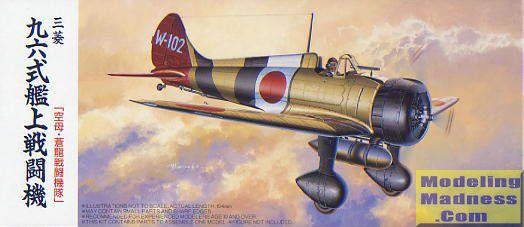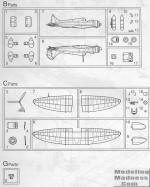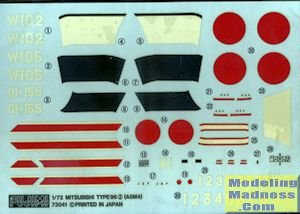
Fujimi 1/72 A5M4 'Claude'
| KIT #: | 72041 |
| PRICE: | $10.00 from a vendor at a show |
| DECALS: | Three options |
| REVIEWER: | Scott Van Aken |
| NOTES: |

| HISTORY |
The aircraft entered service in early 1937, soon seeing action in pitched aerial battles at the start of the Second Sino-Japanese War, including air-to-air battles with the Republic of China Air Force's Boeing P-26C Model 281 "Peashooters" in what was the world's first-ever aerial dogfighting and kills between monoplane fighters built of mostly metal.
Chinese Nationalist pilots, primarily flying the Curtiss Hawk III, put up a valiant fight against the Japanese, but the A5M was the better of almost every fighter aircraft it encountered. Though armed with only a pair of 7.7 mm machine-guns, the new fighter proved effective and damage-tolerant, with excellent maneuverability and robust construction. Later on A5M's also provided much-needed escorts for the then-modern but vulnerable Mitsubishi G3M bombers.
The Mitsubishi team continued to improve the A5M, working through versions until the final A5M4, which carried an external underside drop tank to provide fuel for extended range.
The A5M's most competitive adversary in the air was the Polikarpov I-16, a fast and heavily armed fighter flown by both Chinese Air Force regulars and Soviet volunteers. Fierce air battles in 1938, especially on 18 February and 29 April, ranked among the largest air battles ever fought at the time. The battle of 29 April saw 67 Polikarpov fighters (31 I-16s and 36 I-15 bis) against 18 G3Ms escorted by 27 A5Ms. Each side claimed victory: the Chinese/Soviet side claimed 21 Japanese aircraft (11 fighters and 10 bombers) shot down with 50 Japanese airmen killed and two captured having bailed out while losing 12 aircraft and 5 pilots killed; the Japanese claimed they lost only two G3Ms and two A5Ms shot down with no less than 40 Chinese planes shot down.
104 A5M aircraft were modified to accommodate a two-seater cockpit. This version, used for pilot training, was dubbed the A5M4-K. K version planes continued to be used for pilot training long after standard A5Ms left front-line service.
Almost all A5Ms had open cockpits. A closed cockpit was tried but found little favor among Navy aviators. All had fixed, non-retractable undercarriage. Wheel spats were a feature of standard fighters but not training planes.
The Flying Tigers encountered the Type 96, although not officially, and one was shot down at Mingaladon airfield, Burma on 29 January 1942.
Some A5Ms remained in service at the end of 1941 when the United States entered World War II in the Pacific. US intelligence sources believed the A5M still served as Japan's primary Navy fighter, when in fact the A6M 'Zero' had replaced it on first-line aircraft carriers and with the Tainan Kōkūtai in Taiwan. Other Japanese carriers and Kōkūtai (air groups) continued to use the A5M until production of the Zero caught up with demand. The last combat actions with the A5M as a fighter took place at the Battle of the Coral Sea on 7 May 1942, when two A5Ms and four A6Ms of the Japanese carrier Shōhō fought against US planes that sank their carrier.
In the closing months of the war most remaining A5M airframes were used for kamikaze attacks.
| THE KIT |
 This
kit comes from 1996 and is quite typical of Fujimi kits of the time, meaning it
is quite good. Thanks to the simplicity of the aircraft there are two main grey
sprues plus a small clear sprue holding the windscreen. The cockpit is adequate
though uninspired with a floor, rear bulkhead, control stick and instrument
panel. There is a decal for instruments. This fits onto the lower wing, which
is, in turn inserted into the completed fuselage halves. Inside each fuselage is
framework detail.
This
kit comes from 1996 and is quite typical of Fujimi kits of the time, meaning it
is quite good. Thanks to the simplicity of the aircraft there are two main grey
sprues plus a small clear sprue holding the windscreen. The cockpit is adequate
though uninspired with a floor, rear bulkhead, control stick and instrument
panel. There is a decal for instruments. This fits onto the lower wing, which
is, in turn inserted into the completed fuselage halves. Inside each fuselage is
framework detail.
The wing is a complete lower wing with separate upper halves. An insert fits into the forward lower wings. Tailplanes are a single piece and slot into the rear fuselage. The main landing gear legs are in two halves, trapping the wheel in between them. The tail gear is molded into a fuselage half.
The only thing for under the fuselage is a drop tank with its corresponding pylon. A tail hook is included. The engine is a single row radial which is attached to the forward fuselage. Then the exhaust ports are glued on, followed by the upper and lower cowling halves, trapping the engine. The final bits consist of a prop and gearbox section that fits onto the engine, attaching the upper wing aileron controls and then the clear windscreen with telescopic sight.
 Instructions
have the usual Gunze paint references. Three options are provided. All are the
Claude's unique light gold color which is mixed using their Radome Tan with a
touch of gold added. They also have black cowlings and red empennages. All three
options are from the carrier Soryu at various times during the plane's career.
The decals are nicely printed, but suffer from the usual off-white issues that
Japanese decals of the time tend to show. There are probably aftermarket ones
available.
Instructions
have the usual Gunze paint references. Three options are provided. All are the
Claude's unique light gold color which is mixed using their Radome Tan with a
touch of gold added. They also have black cowlings and red empennages. All three
options are from the carrier Soryu at various times during the plane's career.
The decals are nicely printed, but suffer from the usual off-white issues that
Japanese decals of the time tend to show. There are probably aftermarket ones
available.
| CONCLUSIONS |
| REFERENCES |
https://en.wikipedia.org/wiki/Mitsubishi_A5M
October 2015
Thanks to me for the preview kit. If you would like your product reviewed fairly and fairly quickly, please contact the editor or see other details in the Note to Contributors.